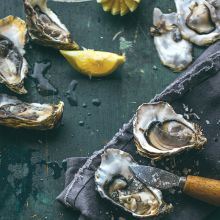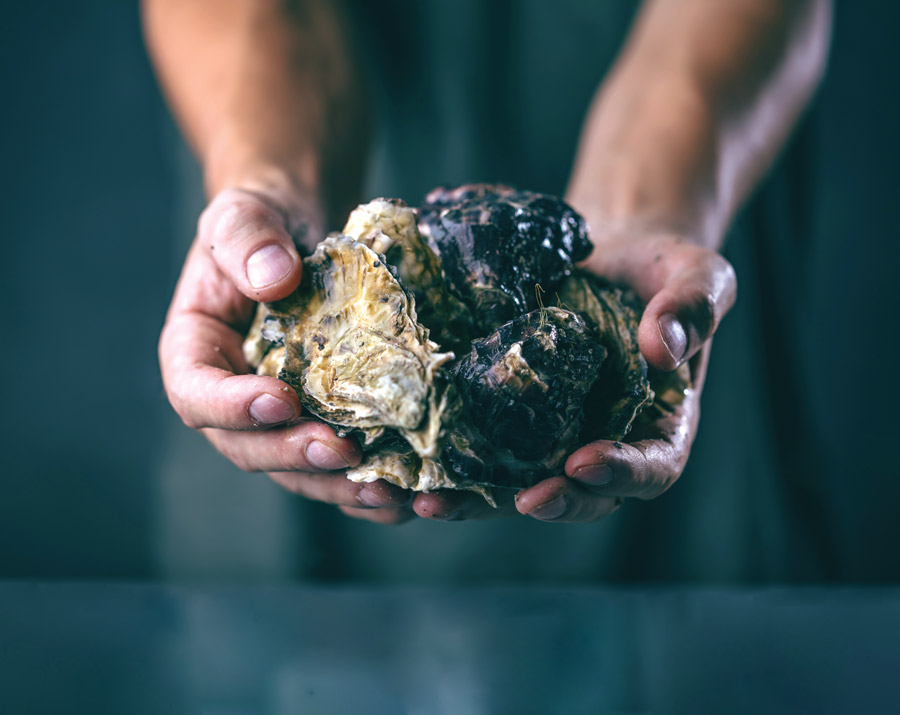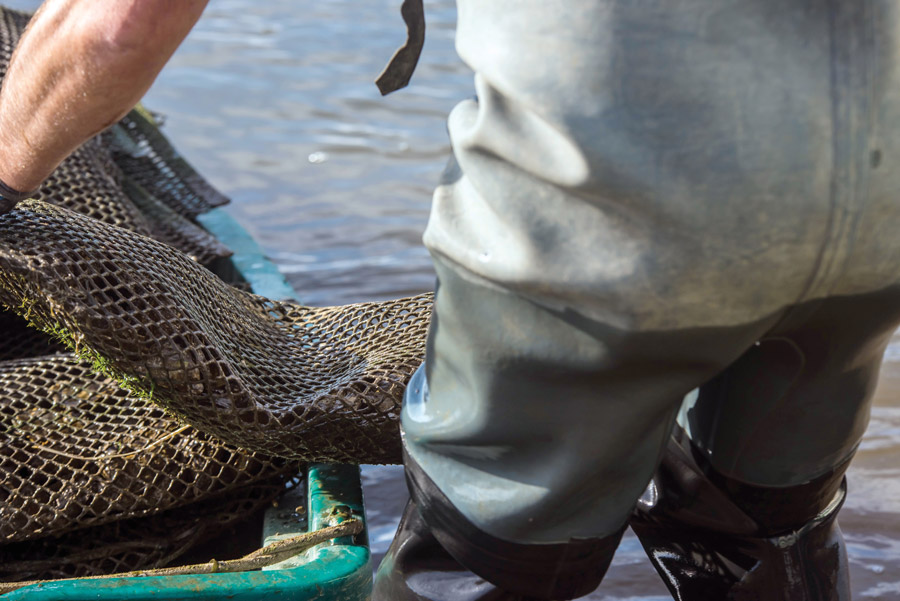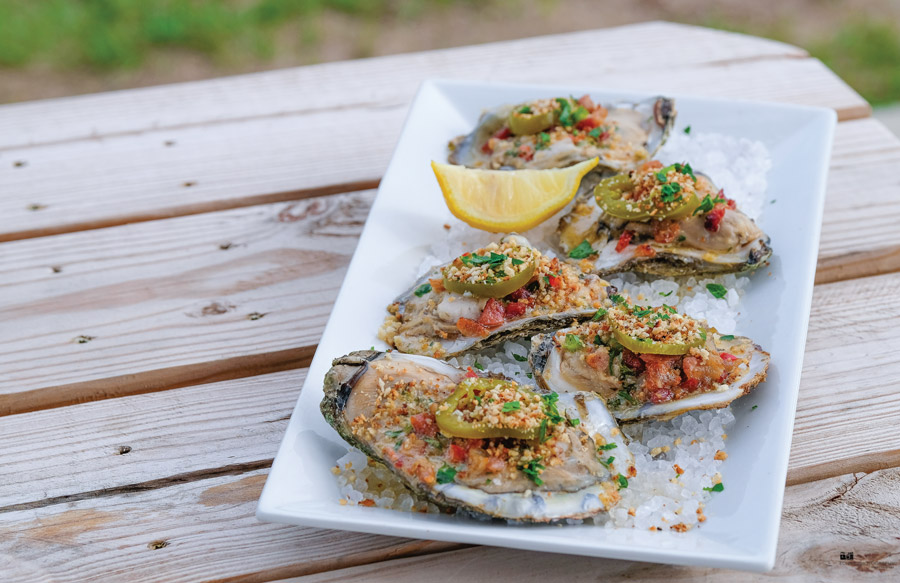Listen To This Article

If you want a true taste of the Outer Banks, eat a locally harvested oyster. Nothing tastes more like the coastal environment than our native eastern oysters (Crassostrea virginica). They taste like the waters where they grow – salty with the perfect hints of minerality and fishiness. If you love oysters, you love them, and if you don’t, well, that just leaves more for the rest of us. Oysters are one of the most-loved seafood options, and lucky for us, they are harvested right here along the Outer Banks.
Oysters All Year Round
It used to be that as the month of April wrapped up, no one ate oysters again until October (when the season for wild harvesting opens). We were committed to the adage that we could only eat oysters in months that had an R in the name. But times have changed. Back then we only ate wild-harvested oysters, but today, thanks to modern oyster farming, we can eat oysters all year round.
Now we can fry a few oysters alongside our softshell crabs in May, slurp chilled oysters with a glass of Albarino in June, pop a few oyster shooters at Fourth of July cookouts and belly up to an oyster bar in August.
Farmed oyster shells are smoother and more polished than wild oysters on the outside, but the oysters themselves are just as tasty. Oyster farms are located in leased sound waters, and the flavor and size of the oysters vary depending on location of the farm and proximity to an inlet. In 2023 North Carolina had 220 shellfish growers with 448 leases on 1,828 acres of public waters, according to the N.C. Division of Marine Fisheries.

The Importance of Oysters
Oysters, wild and farmed, are tasty indeed, but more than a good food, they are a vital part of the coastal ecosystem. As filter feeders, oysters remove harmful pollutants, sediment and excess algae from the water. The bivalve mollusks’ filtering of the water contributes to improved water quality. One oyster can filter 50 to 60 gallons of water a day! Oyster reefs also provide habitat for aquatic animals like fish, shrimp, clams and crabs. Plus, oysters feed a lot of humans and contribute greatly to the state’s economy.
The North Carolina Coastal Federation and other local environmental-based organizations are working to help restore the state’s declining oyster populations and repair the state’s water quality by building oyster reefs, helping people to recycle their oyster shells for reefs and encouraging local governments to prevent stormwater runoff in the sounds (the biggest polluter of coastal waters). If you’d like to know more about how to recycle your oyster shells or volunteer with the N.C. Coastal Federation, click here.
NC Oyster Trail
The Outer Banks is part of the NC Oyster Trail, a grassroots effort to help sustain and grow North Carolina’s oyster industry. Launched in 2020, the trail links oyster farms, restaurants, educational centers and seafood markets all along the North Carolina coast and is administered by N.C. Coastal Federation and N.C. Sea Grant in partnership with the N.C. Shellfish Growers Association. For more information and details click here.
The Outer Banks currently has five oyster farms on the trail: Cape Hatteras Oyster Company, Slash Creek Oysters, Sticky Bottom Oysters, Savage Inlet Oysters and Ocracoke Mariculture.

Where to Eat Oysters
There are many places to enjoy both wild and farm-raised oysters year-round on the Outer Banks. At many local restaurants, you can have an oyster-tasting experience with oysters steamed or on the half-shell. Be sure to ask where they came from. If they’re not from the Outer Banks, they might be from one of the other oyster farms in North Carolina or from one of Virginia’s many oyster farms. You can also find locally harvested wild and farmed oysters at local seafood markets.
Outer Banks Oyster Farms
The greater Outer Banks area, including the Pamlico Sound around neighboring Hyde County, has eight oyster farms, some of them on the trail and others not. Some of the farms offer boat tours to see their operations and some just sell their oysters to markets or restaurants directly.
THESE OYSTER FARMS CURRENTLY OFFER TOURS:
Ocracoke Mariculture/ Devil Shoals Oyster Company, Ocracoke
Slash Creek Oyster Co., Hatteras
Sticky Bottom Oyster Company, Hatteras
Cape Hatteras Oyster Company/ Hatteras Salts, Buxton
OTHER LOCAL OYSTER FARMS:
Kinnakeet Oyster Company, Avon
Savage Inlet Oysters, Oregon Inlet
Little Star Oyster Farm, Hyde County
Currituck Oyster Company, Hyde County
DIY Oyster Roast
Show off a little seasonal entertainment by hosting a cozy oyster roast. This social event, at its finest, features the best elements of the off-season: chilly weather, warmth emanating from a bonfire or grill or steamer (preferably all three), your brew of choice, good company and, of course, all the oysters you can eat and their appropriate sauces. But you can do this anytime of year.

Build the Oyster Bar
If you’re building oyster tables, make them taller than normal so guests aren’t leaning over the whole night. Make them skinny too – we recommend 8 feet long and about 2 feet across. Consider cutting a hole in the middle to place your trash can under to catch the shells (then donate those shells to a local organization like North Carolina Coastal Federation or The Nature Conservancy at Nags Head Woods Preserve). Rig some high poles on both ends that are sturdy enough to anchor a rope that you stretch from end to end onto which you attach strings of lights so you can see what you’re eating without taking up table space with lanterns. Now...moment of happiness: Plug in those lights and step back and observe your handiwork. It’s pretty, in and of itself, even before those steaming shells are dumped onto the table.
In case this is your first time, you’ll want saltine crackers, oyster knives and sauces at your oyster bar too. If it’s cold, consider butter warmers to keep your butter melted. You could offer oyster gloves for the shucking process, but personally, we prefer to have torn-up pieces of old towels on the table also to place between hand and oyster. Oh, and beer. Lots of beer.
Prepare the Oysters
Start by buying a bushel of oysters from a local seafood market or directly from an oyster farmer. They’ll likely come in a big burlap bag for easy hauling. If they’re wild oysters, wash them before preparing them to remove any mud or sand.
You can steam your oysters in a steamer setup for five minutes or pop them on the grill for about eight to ten. In a pinch you can roast oysters in a 425 F oven for about 15 minutes. However you are cooking them, keep an eye on them. Right as they begin to pop open, they are done.
Dump batches of the warm oysters along your oyster table. Make sure you have plenty of oysters knives for everyone to open their own.
Using oyster knives, pry open the oysters from the seam where the two shells meet. Once open, use your knife to separate the oyster meat from the shell. Dip your oyster into melted butter or cocktail sauce and put in on a saltine cracker. Melted butter with a few dashes of Tabasco is an excellent dipper as well.
Pop the whole oyster and or oyster/whole cracker in your mouth at once. No one bites an oyster in half. You have to eat it whole.
Let the Oysters Come to You
Can’t handle building your own oyster bar? Cousins Oysters offers a mobile oyster bar and they come to you. They bring locally sourced oysters (plus the beverages) directly to your location, and they do all the work of preparing raw or roasted oysters, shucking and serving with a range of flavorful sauces. cousinsoysters.com
OUTER BANKS OYSTER EVENTS
Outer Banks Seafood Festival - October 21
Soundside Event Site, Nags Head
Tide to Table:Exploring Oyster Ecology, Farming and Culinary Delights - October 27
Coastal Studies Institute, Wanchese
The Big Currishuck - November 25
Sanctuary Vineyards, Jarvisburg
Shuck Hatteras II Oyster Festival - December 15 and 16
Cape Hatteras KOA Resort, Rodanthe


 Molly Harrison is managing editor at OneBoat, publisher of OuterBanksThisWeek.com. She moved to Nags Head in 1994 and since then has made her living writing articles and creating publications about the people, places and culture of the Outer Banks.
Molly Harrison is managing editor at OneBoat, publisher of OuterBanksThisWeek.com. She moved to Nags Head in 1994 and since then has made her living writing articles and creating publications about the people, places and culture of the Outer Banks.




